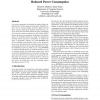Free Online Productivity Tools
i2Speak
i2Symbol
i2OCR
iTex2Img
iWeb2Print
iWeb2Shot
i2Type
iPdf2Split
iPdf2Merge
i2Bopomofo
i2Arabic
i2Style
i2Image
i2PDF
iLatex2Rtf
Sci2ools
LCTRTS
2000
Springer
2000
Springer
Reordering Memory Bus Transactions for Reduced Power Consumption
Low energy consumption is becoming the primary design consideration for battery-operated and portable embedded systems, such as personal digital assistants, digital still and movie cameras, digital music playback, medical devices, etc. For a typical processor-based system, the energy consumption of the processor-memory component is split roughly 40-60% between the processor and memory. In this paper, we study the impact of reordering memory bus traffic on reducing bus switching activity and power consumption. To conduct this study, we developed a software tool, called MPOWER, that lets an embedded system designer collect a trace of memory bus accesses and determine the switching activity of the trace, given design parameters such as data and address bus width, bus multiplexing, cache size, block size, etc. Using MPOWER, we measured the effectiveness of reordering memory accesses on switching activity. We found that for small caches, which are typical of embedded processors, the number...
| Added | 25 Aug 2010 |
| Updated | 25 Aug 2010 |
| Type | Conference |
| Year | 2000 |
| Where | LCTRTS |
| Authors | Bruce R. Childers, Tarun Nakra |
Comments (0)

